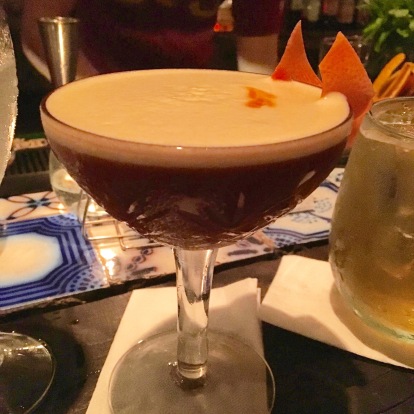51 rue Faubourg Saint-Denis, 75010
As much as I adore Le Calbar, I draw the line at going there two nights in a row, so when I go to Paris for a weekend, I usually need a different place to go one of the nights. This past weekend I opted for a bar in a part of the city that is less familiar to me but definitely a hub for nightlife – the 10th arrondisement.
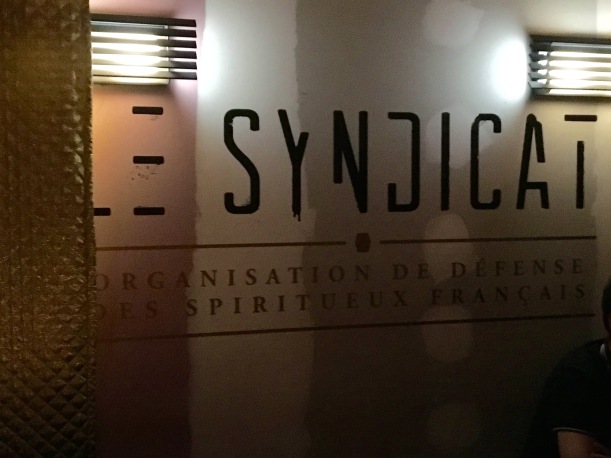
Le Syndicat (whose full name according to its Facebook page is Le Syndicat – Organization de Défense des Spiritueux Français) is a bit of a hole-in-the-wall when viewed from the street despite its perfectly normal sized door. The walls surrounding the entrance were papered over, and neither the name of the bar nor its address was visible as a result. We saw only an open doorway manned by a bouncer and a lively looking crowd beyond. As luck would have it, a group of three had just vacated a table, so we quickly took it over and began poring over the menu.
I’m beginning to realize that one of the hallmarks of craft cocktail bars is the relatively indecipherable list of ingredients for each drink. Sometimes I don’t even recognize the base liquor, so it’s even more difficult to imagine what any one drink will taste like. My strategy is to identify one ingredient that I know that I will like and take my chances, hoping that the total package has at least a hint of that taste, and so far this has served me well.
Le Syndicat has one such cocktail list – it’s only two pages, but it leaves plenty to wonder about before the drinks arrive. I first went for La Douce Prune, which contained the following ingredients:
- Vieille Prune (literally, Old Plum – no idea what this was in terms of a liquor)
- Vermouth rouge (red Vermouth)
- Sirop de Cidre aux baies rose (pink berry cider syrup?)
- Citrons frais pressés (fresh pressed lemons)
- Blanc d’oeuf (egg white)
I’m generally a fan of drinks involving egg white because it means it will have a foamy layer on top, so I went with it even though I didn’t really know what to expect from the other ingredients individually or collectively. I’m glad I did – the end result was both beautiful and delicious.
My friend Ali ordered one with a much cooler name, Pimp & Mousse (a play on words as it contained grapefruit, which in French is pamplemousse). This had a similarly bizarre list of ingredients, ending with a grapefruit basil mousse that accounted for about half the large wine glass in which it was served.
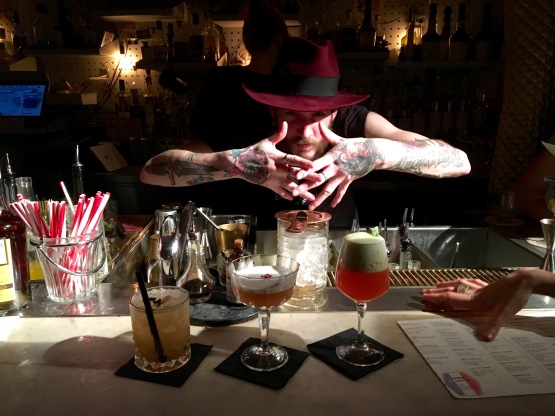
Both of these first drinks came from the part of the menu titled “Insane St Denis Style”; for our second round, we opted for some of the “Syndicat Classiques”, which were twists on classic cocktails made with all-French ingredients. This time I ordered one called a Jazzybelle (and honestly I’m not sure which classic cocktail inspired this) containing, most mysteriously, “liqueur de sapin” – pine liqueur. The end result ended up being fruity thanks to some apple syrup, lemon juice, and a berry syrup served separately in a small jar, to be added at my discretion (a fun touch). We were also pleased by the cool apple slice arrangement on top:
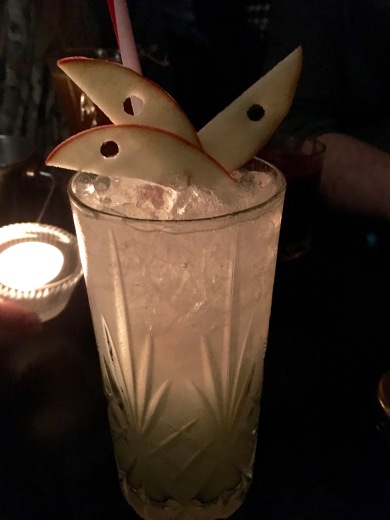
Ali’s next drink was called Modern Thyme and was not so much to my taste, but it still gets points for presentation, as it arrived in a chemical beaker/test tube set into a bucket and with a sprig of thyme tied around the stem:
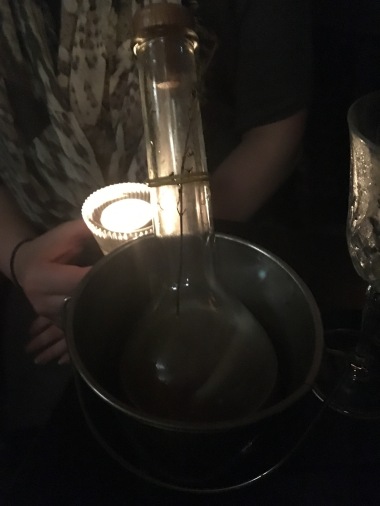
Ali’s boyfriend Jonathan got a really interesting drink during this round as well. The Drop the Beet looked like beet juice and tasted like it too, albeit with a bit more sweetness than usual. I would never have thought it contained alcohol, but it had both Calvados (a French apple brandy) and red Vermouth in it, along with some honey ginger syrup.
Value: These drinks were all about 13 euros a piece, which puts Le Syndicat in line with the other famous cocktail bars of Paris. Both of my drinks were excellent and worth the price.
Bartenders: I believe there was standing room only at the bar while we were there; at any rate, I did not have the opportunity to sit and chat with the guys making the drinks. I did get the impression that on a quieter night this would probably be a fun place to be and that you’d be able to do that; the bartender who made our first round of drinks wasn’t at all bothered by my taking pictures of them and gamely jumped in the last one, as you see above. I assume from the creativity of the menu that they’d be able to make even more interesting drinks if you wanted something bespoke, but I’ll have to wait for another trip to see if that’s true.
Atmosphere: There are two main rooms, one smaller one by the door (where the bar is) and one larger one in the back. There is just the right amount of lighting, and we enjoyed the nostalgia brought on by their music selection – rap and R&B hits from the 90’s and early 2000’s. Everyone that I saw and heard appeared to be French, all in their late 20’s and early 30’s and dressed casually. The bar is on a street with other bars as well, so it’s on a bit of a drag, but it’s not a fancy area and retains a neighborhood feel (as is true for most areas in Paris other than Bastille).
Overall verdict: would definitely go back!

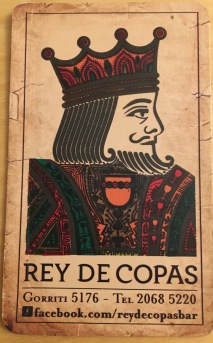 This was my favorite bar in Buenos Aires, and we happened upon it thanks to a recommendation from a bartender at another great place called Olsen (which I heartily recommend if you like martinis and are interested in vodka flights paired with Scandinavian hors d’oeuvres, served in a beautifully lit garden; the martini pictured on the home page is from there). We asked the bartender at Olsen where he would go for a good drink, and Rey de Copas was his first recommendation. He even gave us their business card, which is printed on a playing card!
This was my favorite bar in Buenos Aires, and we happened upon it thanks to a recommendation from a bartender at another great place called Olsen (which I heartily recommend if you like martinis and are interested in vodka flights paired with Scandinavian hors d’oeuvres, served in a beautifully lit garden; the martini pictured on the home page is from there). We asked the bartender at Olsen where he would go for a good drink, and Rey de Copas was his first recommendation. He even gave us their business card, which is printed on a playing card!
